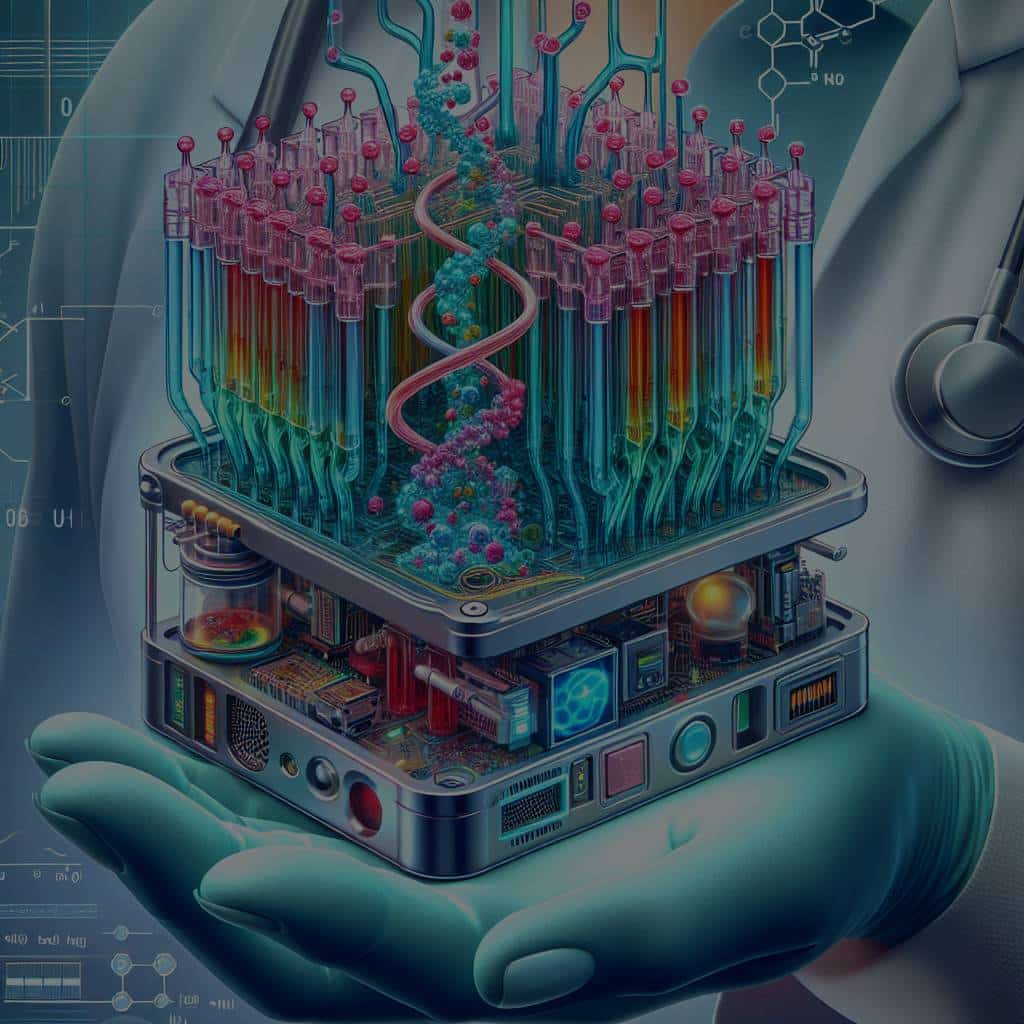What Advances in Microfluidics Are Enabling Portable Diagnostic Lab-on-a-Chip Devices?

Explore the fascinating realm of microfluidics, a rapidly evolving technology that is revolutionizing point-of-care (POC) diagnostics. As microfluidics becomes increasingly sophisticated, it drives the development of portable diagnostic lab-on-a-chip devices. You’ll delve into the key advancements in this field and understand how they’re reshaping healthcare delivery, allowing for rapid and efficient disease monitoring and detection.
Microfluidics: The Heart of Miniature Lab Technology
Microfluidics is the science of manipulating and controlling fluids at the microscale, typically within networks of channels no thicker than a hair. These microfluidic systems are integral to lab-on-a-chip devices, enabling the miniaturization and automation of lab processes.
Additional reading : What Role Can AI Play in Streamlining the Claims Process in Insurance?
The past decade has seen significant developments in microfluidic technology. Thanks to the work of scholars and researchers, you can now find these devices in diverse applications from DNA sequencing to immunoassays. Google Scholar lists thousands of research papers dedicated to the subject, attesting to its growing importance in the scientific community.
One of the major advantages of microfluidics is its ability to process small volumes of fluids. This requires less sample material and enables faster reactions, facilitating rapid testing. Moreover, microfluidics reduces waste, lowers costs, and allows for parallelization, where multiple tests are conducted simultaneously.
In the same genre : Educational illustrations about pets and wildlife
Advances in Fabrication Techniques
One of the key advances enabling the rise of microfluidic devices has been the improvement in fabrication techniques. Traditionally, creating a microfluidic chip was a complex process requiring specialized equipment and clean-room facilities. However, recent developments have significantly simplified and democratized the process.
One such development is the use of soft lithography, a technique that allows for the creation of high-quality and cost-effective microfluidic chips. Another notable advance is 3D printing technology. This approach enables the rapid and relatively inexpensive creation of microfluidic devices, opening up new opportunities for researchers and developers in the field.
Progress in Microfluidic-based POC Devices
Microfluidic-based POC devices are emerging as a transformative tool in healthcare delivery. These devices offer rapid and reliable diagnostic testing right at the point of care. This is a game-changer in medical care, particularly in resource-limited settings or emergency situations where timely diagnosis is crucial.
Microfluidic-based POC devices have been developed for a range of applications including blood glucose monitoring, diagnosis of infectious diseases, and cancer detection. These devices offer several advantages over traditional lab testing. They provide rapid results, often within minutes, and require only a small sample volume, typically a drop of blood or saliva.
In addition, developments in sensor technology are expanding the capabilities of these devices. For instance, integrated biosensors in microfluidic chips can detect specific biomarkers, suggesting the presence of a disease. This can significantly improve disease detection and monitoring.
Integration with Smartphone Technology
Another exciting development in microfluidic devices is their integration with smartphone technology. This marriage of technologies has resulted in devices that not only conduct rapid on-site testing but also analyze and transmit results in real-time.
Smartphones can serve as a user interface, data processor, and communication device for a microfluidic system. Using the camera, a smartphone can capture images of the test results from the microfluidic chip. Specialized apps can then analyze these images and provide a diagnosis. In addition, the data can be shared with healthcare providers or uploaded to a cloud database for further analysis.
This integration of microfluidics and smartphones effectively turns your phone into a portable diagnostic lab. This has the potential to significantly reduce diagnostic delays and provide real-time health monitoring.
Microfluidic Systems for Disease Surveillance
In light of recent global health crises, the role of microfluidic devices in disease surveillance is becoming increasingly important. These devices can provide rapid detection and analysis of infectious agents, contributing to faster and more effective responses to outbreaks.
Thanks to advances in microfluidic technology, these devices can detect a wide range of pathogens, from bacteria to viruses. For instance, microfluidic devices have been developed for rapid detection of the Zika virus, HIV, and more recently, the SARS-CoV-2 virus.
By providing rapid, portable, and accurate testing, microfluidic devices are a powerful tool for disease surveillance. They can help health authorities monitor disease spread and implement appropriate control measures more quickly.
In summary, the field of microfluidics is undergoing rapid and exciting changes. From advances in fabrication techniques to the integration with smartphone technology, these developments are enabling the creation of portable diagnostic lab-on-a-chip devices. These devices hold significant potential for revolutionizing healthcare delivery, disease monitoring, and outbreak response.
Chip Devices: A Leap in Environmental Monitoring
While microfluidic devices are transforming healthcare, it’s worth noting their significant impact on environmental monitoring as well. The ability of these devices to test and analyze small quantities of fluid rapidly has massive implications for monitoring environmental conditions and changes.
Microfluidic lab-on-chip devices have been used in the detection of contaminants such as heavy metals, organic compounds, and bacteria in water and soil samples. These devices are capable of handling extremely small volumes of samples, thus making them a suitable tool for environmental monitoring.
In a study listed on Google Scholar, a research team developed a microfluidic chip that could detect trace amounts of lead in water samples. Another team created a chip that can identify a variety of pesticides present in a sample. With these advancements, microfluidic devices offer a faster, lower-cost and more efficient method of environmental monitoring compared to traditional laboratory methods.
The portability of microfluidic devices is another notable advantage. Field scientists can carry these devices to remote areas, enabling real-time testing and monitoring of environmental parameters. This is particularly essential in locations where access to traditional lab facilities is difficult or non-existent.
In addition, the application of integrated microfluidic systems in environmental monitoring also allows for continuous and automated monitoring. These systems can be set up to sample the environment at regular intervals, providing an extensive dataset over time. This allows for the tracking of long-term environmental trends and changes, providing vital information in the efforts to combat climate change and protect biodiversity.
Conclusion: Advancements in Microfluidics Redefines Diagnostic and Monitoring Paradigms
The field of microfluidics has come a long way in the past decade. It has evolved from a niche scientific concept into an integral part of modern diagnostic and monitoring devices. The advancements discussed in this article, from fabrication techniques to integration with smartphones, are just the tip of the iceberg.
Researchers are continually pushing the boundaries of what’s possible with microfluidic systems, resulting in even more sophisticated and versatile devices. The application of these devices extends far beyond healthcare and disease surveillance. They’re also becoming an invaluable tool in environmental monitoring, providing crucial data to help safeguard our planet.
Indeed, portable diagnostic lab-on-a-chip devices have transformed the way we approach diagnostics and monitoring. They offer the promise of rapid, low-cost, and highly accurate testing, whether it’s for detecting the presence of the SARS-CoV-2 virus or monitoring environmental contaminants.
In the future, we can expect to see even more innovative applications of microfluidic technology. The integration of these devices with other technologies such as artificial intelligence and machine learning could lead to unprecedented breakthroughs in diagnostics, disease surveillance, and environmental monitoring.
The expansion of this technology will undoubtedly have a profound impact on how we live and interact with the world. At the heart of it all, microfluidics will continue to be the driving force behind these developments, paving the way for a healthier, safer, and more sustainable world.
